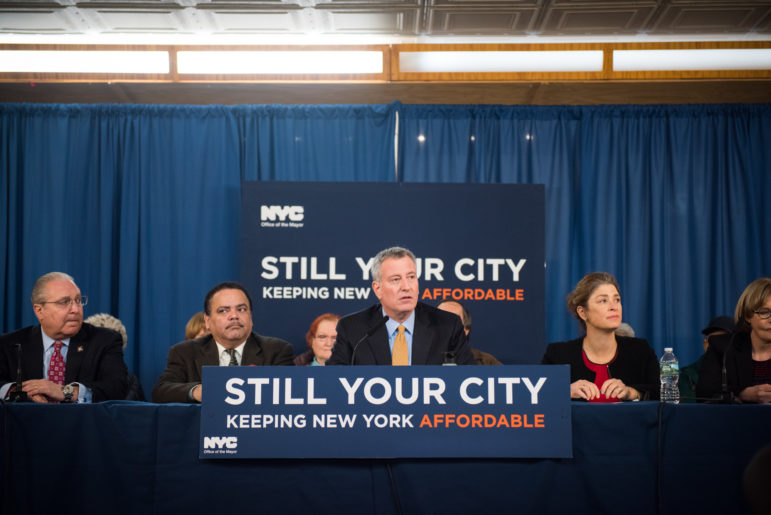
Edwin J. Torres/Mayoral Photography Office
New York City Mayor Bill de Blasio announced that his administration financed more affordable housing in 2016 than in any time in the past 25 years on Thursday.
At a press conference on Thursday, Mayor de Blasio laid out some significant achievements. Three-years in, the administration is ahead of schedule to meet its ambitious target of building or preserving 200,000 units of affordable housing. 62,506 units are completed or in the pipeline, and last year the number of affordable units created or preserved reached a 25-year high.
The city has also surpassed its goal of dedicating 8 percent of units in the plan to families making below $24,480 a year for a family of three—a goal advocates have criticized as far too low. In 2016, 19 percent of units went to such families, bringing the total over the three years to more than 14 percent. Some advocates, while still calling for more low-income housing, have commended the boost.
The mayor and his top officials on Thursday placed a special focus on the issue of displacement, though without saying as much. Under a banner that read “Still Your City: Keeping New York Affordable,” and surrounded by seniors from a nonprofit housing complex in Williamsburg where the city has completed a $19 million preservation deal, the mayor emphasized the importance of making sure New Yorkers know “this still is your city, and you’re going to see this affordable housing plan ensure for half a million New Yorkers that it will be their city for decades and decades to come.” Housing commissioner Vicki Been described the importance of giving families the opportunity to remain within their social networks and raise their kids in the same neighborhood.
But some neighborhood advocates argue that the mayor is putting low-income communities at risk of losing their communities through neighborhood rezonings—even if 20 to 30 percent of the housing is required to be affordable under the new mandatory inclusionary housing policy, and even if there are added tenant legal services and other new supports to help stem displacement.
As City Limits reported Tuesday, the link between displacement and zonings has not been well researched.
Addressing doubts about rezonings
Asked to address these concerns, the mayor recognized the possibility that a rezoning could exacerbate market pressures in a neighborhood.
“There is a strategy you could choose, which is essentially a status quo strategy, where you say, ‘We’re not going to do rezonings because we fear any intensification of development and we’d rather leave the status quo in place even though we won’t get new affordable housing built, we still think it nets out better.’ You can make that argument, right? Because the cost won’t go up in the neighborhood,” he said. “Honestly, if I believed that is what really happened I might find that an appealing option.”
But he said that as a Brooklynite, he had seen multiple neighborhoods gentrify without any rezoning, citing his own experience of Park Slope, which he said had become unaffordable by the early 2000s (though some believe its unaffordability has been exacerbated by a rezoning that occurred in 2003).
“I came to a conclusion that—and I am critical of the impact of market forces, I have been open about it, I have real questions about the problems of the free enterprise system … that government intervention maximizes our chance of controlling the situation more favorably,” he said, adding that it’s important to provide opportunities for neighborhoods that have long suffered from disinvestment to thrive.
Asked specifically why the city could not provide investments to neighborhoods without a large-scale rezoning, or pursue a kind of rezoning with an even greater amount of affordable housing than is required through the mandatory inclusionary housing policy, the mayor stressed that mandatory inclusionary housing is itself already ambitious, and going any farther would discourage development. Yet he also expressed a willingness to see the policy reworked, if a feasible option arose.
“Now having instituted in the biggest city in the country a mandatory requirement for affordability is a huge step. It is not static. If we find ways to deepen it and improve upon it you know we’re going to grab those,” he said.
At other points in the conference, de Blasio explained that while it is true the neighborhood plans were not moving at the “optimal” pace, that he expects several to move forward soon and that he is not interested in rushing the outcome.
“You have to get it right and you have to listen to the stakeholders and we really believe that a great rezoning is when in the end people feel really satisfied with the outcome,” he said, emphasizing that the bulk of the affordable housing would still come from preservation efforts, not from rezonings.
Do we need 421a?
So far, preservation deals account for about two thirds of the affordable units claimed by the city under de Blasio’s housing effort, up from the 60 percent target in the original plan.
The mayor was also asked whether it was necessary for the state to revive the 421a tax credit, given that the city has been so far able to surpass the administration’s housing targets without it. Some advocates believe the credit, even in a revised form that would require more affordable housing, is a wasteful subsidy to developers. Yet Commissioner Been said the tax credit in its revised form was absolutely necessary to the long-term success of the housing plan.
“Over a ten year period, do we need a good efficient 421a? Yes. It will bring units in, and it will bring them in in some of the most expensive neighborhoods where it would be impossible for us to buy land,” she said.








